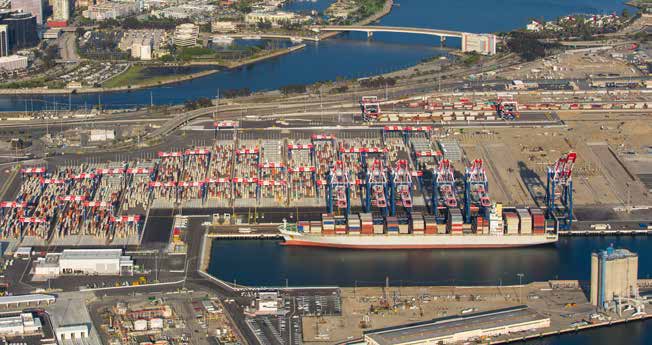Primer for Improved Urban Freight Mobility and Delivery
Operations, Logistics, and Technology Strategies
4. Technology Strategies and Noteworthy Practices

A container ship is unloaded at the Middle Harbor Terminal at the Port of Long Beach, California. In the midst of modernization, this terminal will be highly automated and will use electrification and other technologies to reduce air emissions significantly. An expanded on-dock rail yard will reduce the traffic impacts from the terminal's expanded capacity. Source: Port of Long Beach.
The following section presents seven strategies geared towards improving technology solutions pertaining to freight and goods movement in urban areas. In the following pages, each strategy is profiled as a noteworthy practice, featuring a description of the Technology strategy, its primary objective, and a notable example of the strategy being implemented in the U.S. or abroad. The strategies are organized into three groups: real-time information systems, safety technologies, and environment and energy technologies.
Technology solutions to urban freight and mobility issues have the potential to be implemented by both public and private sector stakeholders. Investing in real-time information systems to communicate truck parking availability and to manage truck parking spaces can help improve mobility and traffic flow, communications, and safety conditions in urban areas. A lack of truck parking near urban areas, which tend to have high concentrations of freight generators such as ports or distribution centers, can lead to higher instances of truck crashes as a result of illegal parking. Truck drivers require adequate truck parking facilities to comply with HOS regulations, and may be forced to park illegally when legal parking is not available or the location of available parking is not known. Real-time information systems at public and private parking facilities can help communicate information to drivers on where it is safe and legal to park near urban areas. Developers of these facilities—whether in the public- or private-sector—can use feedback from truck drivers, carriers, and industry groups to better understand where there is a demand for truck parking, and determine whether more truck parking or real-time availability systems would be most beneficial.
A primary concern for public transportation agencies is roadway safety. This is especially true in congested urban areas where numerous conflicts between modes are present. Technology strategies can also help enhance the safety of urban goods movement in urban areas. Safety-oriented technologies, such as truck design and detection and alerts, can in turn help preserve infrastructure and enhance the communication of potential risks to safety, particularly in high-traffic areas or residential neighborhoods. Truck design enhancements can include expanded mirror and lens systems, truck side guards to reduce bicycle and pedestrian fatalities, and high-visibility cabs. Detection and alert technologies include camera systems, over-height detection systems to prevent crashes and infrastructure damage, advanced blind-spot awareness and warning systems, and external alert systems to warn bicyclists and pedestrians who are near the turning path of the truck. Safety technologies can involve both public-sector stakeholders such as DOTs, as well as trucking and logistics companies who invest and implement these technology solutions.
Lastly, environment and energy technologies can be used to help cities meet emissions-reduction goals to improve quality of life in urban communities. The vehicles and vessels used to transport freight are a significant source of air pollutants. Emissions from diesel engines, especially PM2.5, NOx, and other air toxics can contribute to significant health problems. However, vehicle technologies that produce fewer emissions and/or use alternative fuels can go a long way towards improving air quality. Strategies to spur investment in these areas include anti-idling regulations, clean truck programs at U.S. ports, and financial incentives for freight carriers to upgrade old equipment. These efforts typically require coordination between public sector agencies and trucking/logistics companies, frequently with input from local residents, community groups, and other institutions with an interest in environmental justice and green technology.